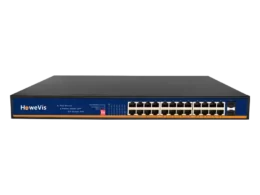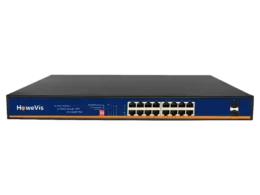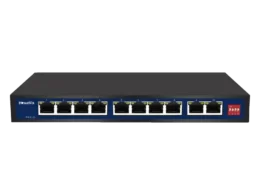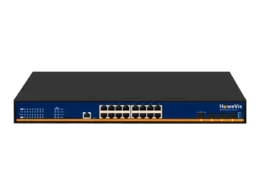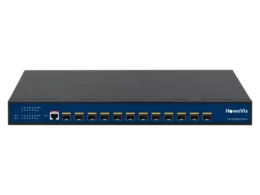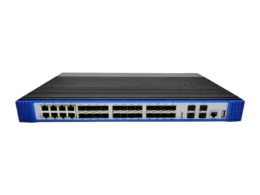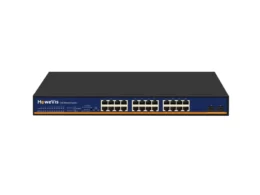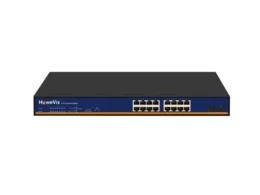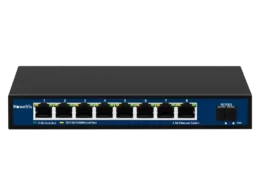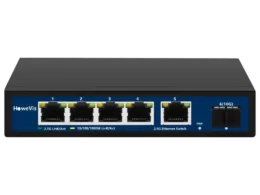If you want the fastest Gigabit switch, consider 1 GbE or 10 GbE switches. These switches allow you to connect multiple devices without affecting the speed.
Switches have evolved in speed over the recent years. They cover the different speed needs of individuals and organizations.
Today, switch speeds range from Ethernet 802.11 to Fast Ethernet IEEE 802.3a standard switches, which run at speeds of up to 10 Mbps and 100 Mbps, respectively.
But, there are also 10 GbE Gigabit switches with speeds of up to 10 Gbps (IEEE 802.3a). These are primarily suitable for ISPs. You will also find 100GbE switches, which are the fastest of all.
So, considering speed alone, 10 GbE switch ranks highest among the Gigabit switches. If speed were the only factor, this is the switch for small to medium-sized businesses or homes.
What Is a Gigabit Switch?
In short, it is an Ethernet-based switch that provides speeds of 1Gbps and above to connected devices.
The gigabit part has transfer speeds of 1000 Megabits per second and above. These switches can aggregate local area networks.
How Fast Are Gigabit Switches?
The current speed ratings of gigabit switches range from 1Gbps, 10Gbps, to 100Gbps. Gigabit switches have an up-link connection to network devices at 1Gbps or more. After that, this connection is subdivided into each downlink port.
Thus, the speed of each port in a gigabit switch depends on the rating of the individual port and also on the overall rating of the up-link port.
The port speed rating is unique to the specific switch model. However, most switches tend to have a uniform rating for all ports.
However, some switches have ports rated at higher speeds than the rest. A switch may have ten ports, with two ports having a gigabit-speed rating, while the rest rate at 10/100Mbps.
You can browse through our collection of industrial Gigabit PoE switches. We have 8-port Gigabit PoE switches, 16-port Gigabit PoE switches, etc.
Understanding 1Gb and 10Gb Gigabit Switches
Small to medium-sized enterprises could hardly afford switches rated 1Gbps or higher. The costs of such switches were prohibitive, making them only affordable for large organizations and businesses.
But things have transformed recently. Many small—and medium-sized enterprises are upgrading to these high-speed gigabit switches today.
1Gb Gigabit Switch
The 1Gbps switch has downlink connectivity to the access switches it serves. These access-layer switches operate 10/100Mbps to their terminal downlink ports. The access-layer switches subdivide the uplink connection speed among their downlink ports.
The central switch serves 1Gbps to access-layer switches in a data center setting. These have a restricted 10/100Mbps downlink port rating.
The aggregated speed from the down-link endpoints aligns with the 1Gbps up-link connection. Thus, it utilizes the total bandwidth.
10Gb Gigabit Switch
The same applies to the 10GbE switch. It is a central switch in a data center and provides 10 Gbps transfer speeds to 10 or fewer switches, with an up-link connection of 1 Gbps.
These switches will then serve 10/100Mbps downwards to the downlink ports.
How to Use a Gigabit Switch to Speed Up Your Network?
If wrongly configured, gigabit switches can become bottlenecks in your network setup. They can slow down your network speeds without loop detection.
Moreover, they can even cause network failure. Thus, knowing how to configure your gigabit switch settings correctly is prudent.
Managed vs. Unmanaged
Gigabit switches come in two types: managed and unmanaged. When buying a switch, we sometimes have to deal with technical jargon.
As a result, it leaves us wondering what the big deal is. It turns out this is a way of giving you a certain amount of control. You will have control over the devices connecting to your network and switch.
A managed switch is flexible and allows you to oversee your network connections. However, it requires different configuration settings to work well.
For example, it comes with VLAN (s) functionality for network segregation. This helps define speeds, security, and other configuration settings for given network segments.
- You can change connection speeds for certain network parts or devices.
- You can further subdivide your network to cater to different devices.
Unlike a managed switch, an unmanaged switch is pre-configured and ready for use. Thus, it is a plug-and-play switch and does not require complicated configuration settings.
Power Over Ethernet – POE
Most network devices need a connection to a power outlet to operate. Of course, it is easy if the power outlet is nearby.
But it gets messy when you have many devices requiring a constant power supply. It’s worse if the sockets or power outlets are far away.
So, Power over Ethernet is an implementation that overcomes these challenges. It transmits electrical power to a switch or router through the same cable link. Besides, a PoE switch has many advantages.
Today, most networked devices are POE-compatible. CCTV cameras, VoIP phones, sensors, switches, and hubs are POE-capable.
Gigabit
It denotes the data transfer capability of a gigabit switch. It guarantees speeds of 10, 100, and 1000Mbps for your devices. Thus, it is excellent for working with huge data transfer needs or many connected devices.
1Gb vs. 10Gb – How to Select?
It may not be easy to decide whether to work with a 1Gbps or 10Gbps Gigabit switch. Different factors come into play, mainly your everyday usage needs.
Factors to consider while choosing a Gigabit switch include:
Virtualization Application
An organization or business using virtualized cloud applications requires higher bandwidth. The same goes for on-site virtualized applications requiring internet connectivity.
The 10Gb Gigabit switch will ensure smoother connectivity in such cases. The same goes for video or multimedia hosting services or video conferencing services.
Picture and video quality remain high and without lags. Video content creators and gamers will benefit most from the 10GbE switch implementation.
There are so many uses for 10 GB Ethernet. These incredible benefits make it worthwhile for businesses to switch to the 10 Gbps Gigabit switch.
Number of Users
Consider these questions: What is the number of users? How many end devices (PCs, phones, laptops, IP cameras, etc.) connect to the switch? And what are your future expansion plans?
It will help plot the bandwidth utilization against time and the number of users. A specific focus on the peak times is necessary.
As a result, it will reveal the network’s traffic load capability. This data forms the basis of the up-scale or down-scale of the current load capability.
Access Point Bandwidth
When considering the bandwidth requirements, wireless access points must be present. Wireless devices may be more powerful than wired ones.
Such a scenario requires a load-balancing configuration. Here, the switch redistributes more bandwidth to the wireless access point.
However, in some instances, the Gigabit switch may serve 10Gb to a 1Gbps up-link switch port. It will significantly limit bandwidth usage. Why? Because the rating of the up-link port cannot utilize the high bandwidth.
Likewise, the same applies to the central switch serving a 1Gbps downlink to a 10/100Mbps switch. Upgrading to a Gigabit industrial PoE switch can significantly improve bandwidth utilization.
Final Thoughts!
You know the fastest Gigabit switch you can choose for your home or business. Even if 10 GbE is the most closed switch, an individual can consider a 1 GbE switch if the speed requirements are low.
The speed requirements and your business needs will determine the choice. The implemented switch should not become a bottleneck or impediment to business productivity.
Thus, make sure to measure your peak and off-peak bandwidth utilization. And do not hesitate to up-scale if the business calls for it.


